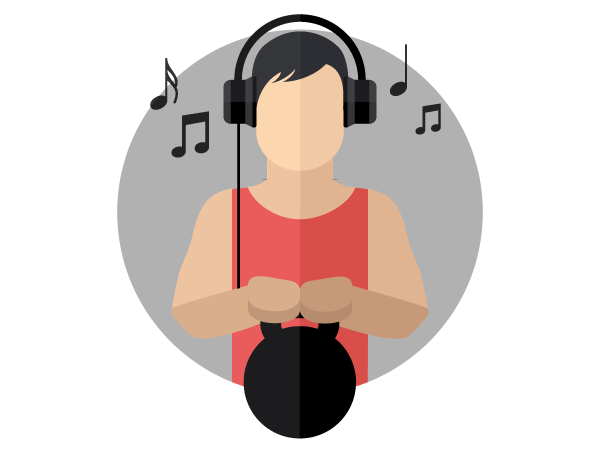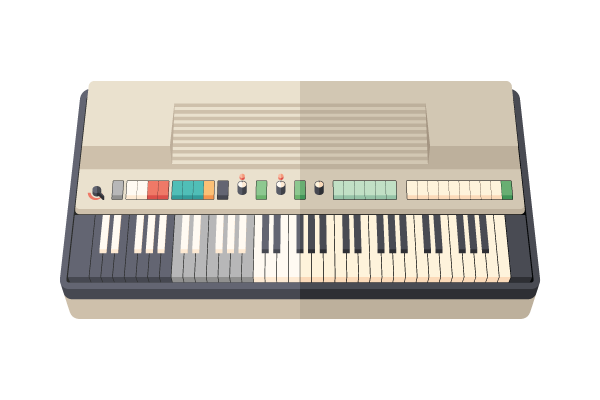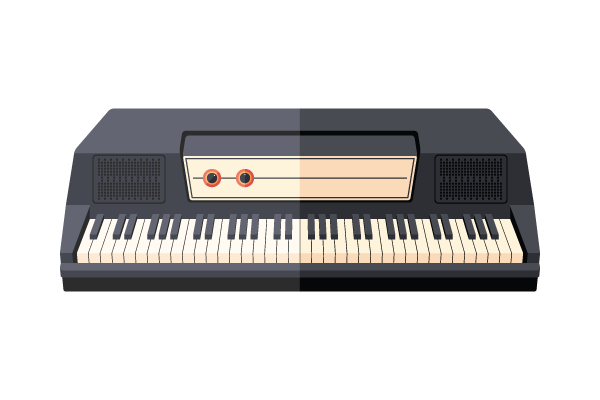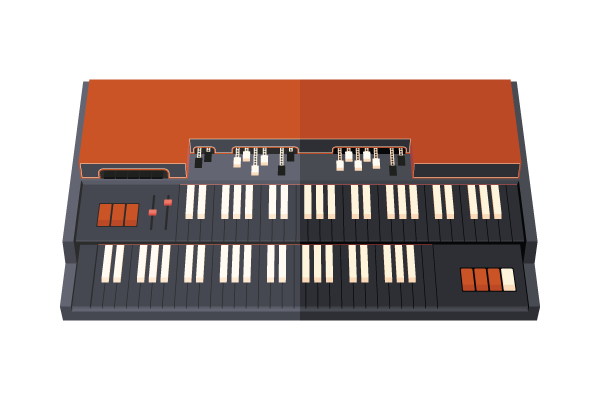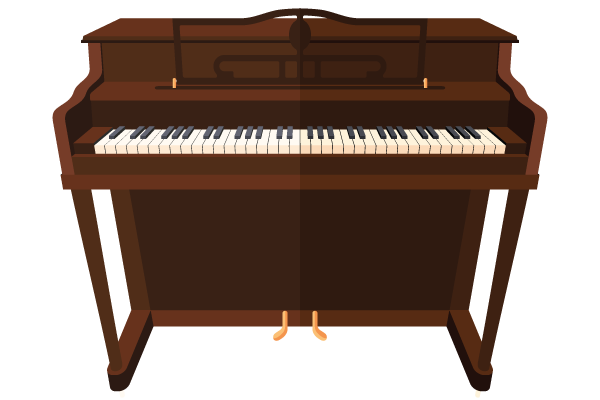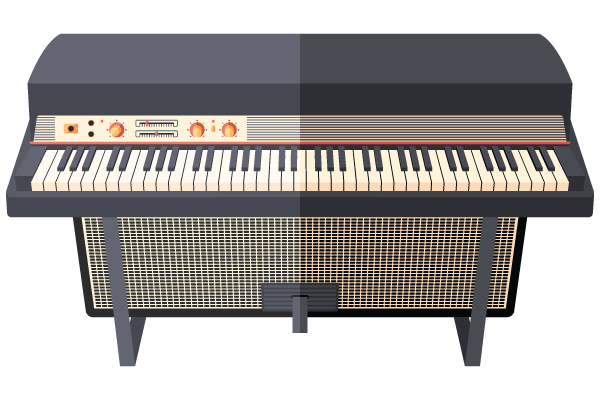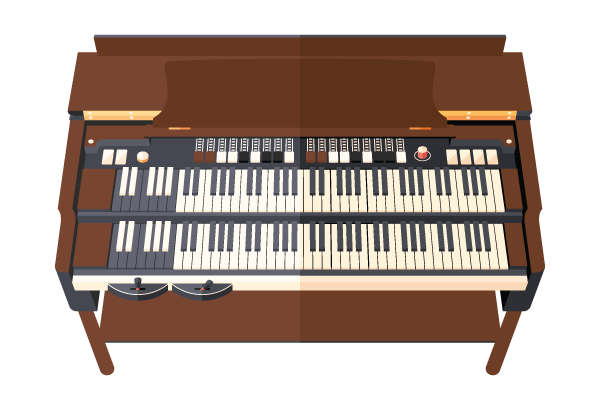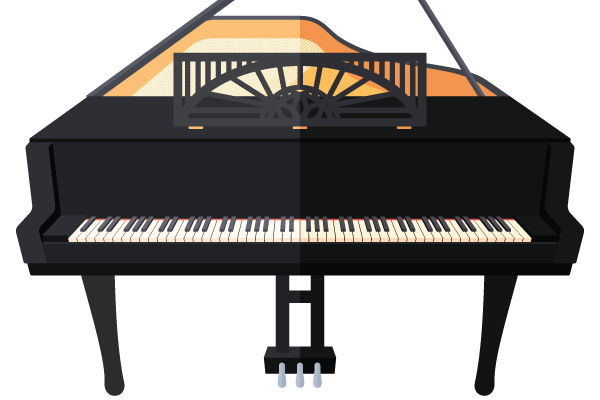How to Play the Piano? Starter Guide
Playing piano may be one of the most wished-for skills in the world. Kids everywhere ask for keyboards each holiday and birthday season. Parents who want their kids to get a musical education usually sign them up for piano lessons. Even adults, seniors et al., who wish to learn a new skill, take up a hobby or find ways to express themselves at different stages in life look no further than the piano.
Attaining a piano-like instrument (or keyboard) of some sort has never been easier, and with myriad resources, free and paid, to start learning online with nothing more than a basic internet connection and a smartphone, learning the piano has never been more accessible.
Benefits of Learning to Play the Piano
The piano in many ways could be considered the premier, perfect musical instrument. At around 370 years old, the modern pianoforte has been adopted in some form by nearly every nation, musical system, and used in every musical technology on Earth.
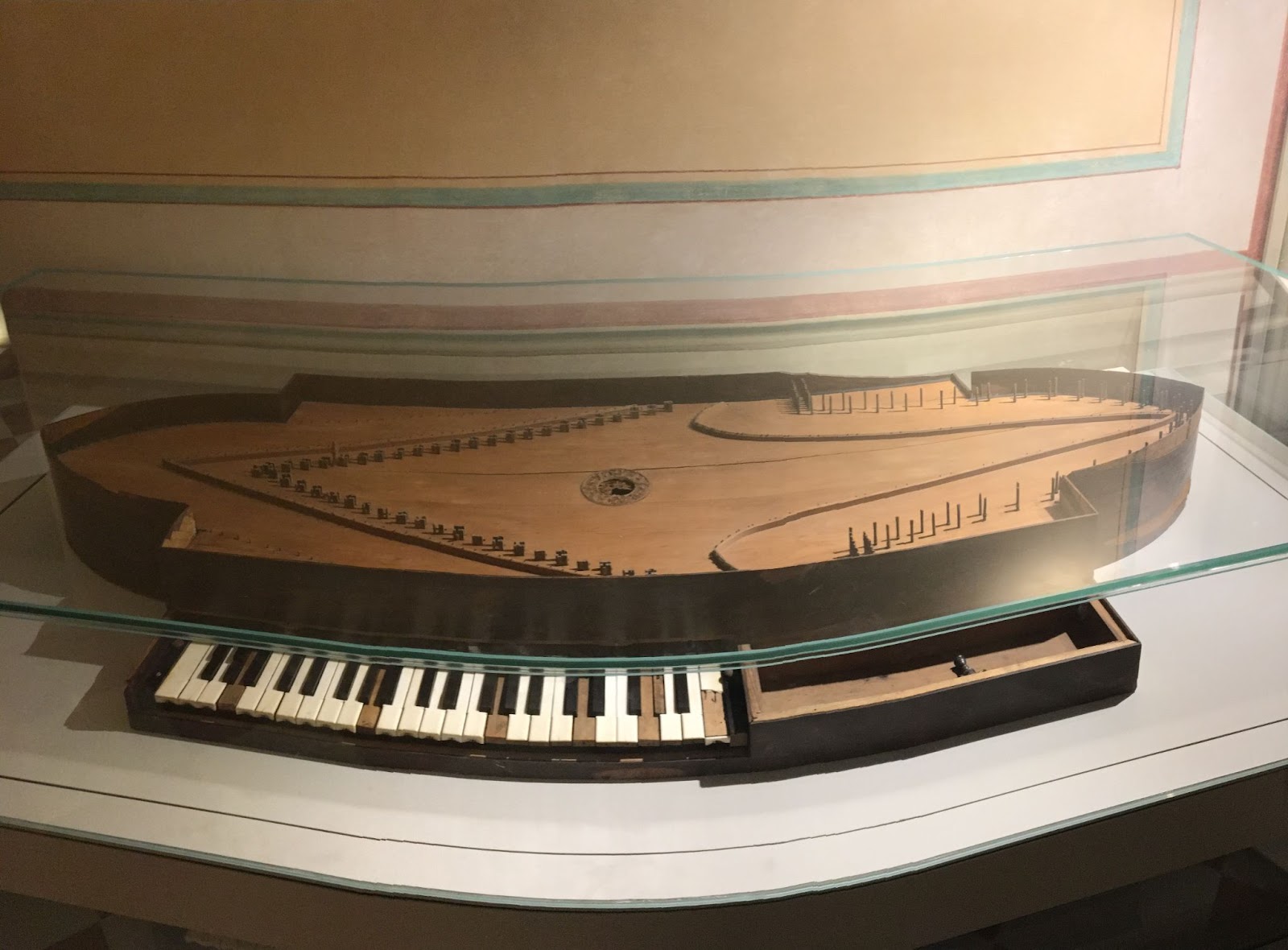
One of the first known pianos, housed at the Accademia D'Arte in Florence, Italy
From the keyed system of the piano, and its predecessors, the harpsichord, organ, and clavichord, we derive things like the piano roll (used in digital composing and MIDI programming), the MIDI keyboard itself, and nearly every system of teaching music theory outside of perhaps solfeggio (sight-singing).
When it comes to expanding your knowledge of music theory, boosting your musical IQ, and breaking down creative barriers, the piano may just be the perfect place to start.
Both piano and guitar are “chorded” instruments. They are “polyphonic”, meaning capable of naturally producing more than one note at a time. Piano and guitar are polyphonic as opposed to monophonic, which means single note. Monophonic instruments include brass and woodwinds, some synthesizers, and the human voice.
Other instruments that are polyphonic are stringed instruments like violin, viola, cello, and bass. However, using conventional methods, these instruments can only produce two-note “double stops” as opposed to full triads; three, four, and five-note chords.
Most importantly, the piano is linear, meaning the notes on the piano are arranged in a fixed order from lowest to highest. This sets it apart from other chorded instruments such as guitar (where notes and patterns overlap) as it makes identifying and visualizing chords, scales, and patterns much more intuitive. Therefore, the piano is most often used to teach music theory, compose, and create.
Having a solid foundation on the piano will without a shadow of a doubt boost your musical abilities elsewhere, even when it comes to playing other instruments. Drummers who go to school for jazz performance will often take piano classes, to better learn the language of their collaborators. Electronic producer Deadmau5 was quoted in Masterclass saying he wished he could play piano better instead of having to hand program his musical ideas as MIDI notes inside of a DAW. Theoretically, learning to map abstract musical concepts to the piano keyboard will make your musical education and ear training that much easier.
The Musical Alphabet
Music, just like spoken language, has its own unique alphabet, called the musical alphabet. Learning the musical alphabet is the first step in understanding the universal language of music. The musical alphabet uses characters from the standard English alphabet with a few additions such as # (sharp) and ♭ (flat). The flat sign is sometimes written digitally using the lowercase letter “B” (b).
Here is the alphabet start to finish:
C - C#/D♭ - D - D#/E♭ - E - F - F#/G♭ - G - G#/A♭ - A - A#/B♭ - B
The musical alphabet is made up of 12 notes labeled with the letters A through G, but begins with the letter “C”. This is because the major musical key associated with “C” contains no sharp or flat notes, in other words, it is made up of all the white keys on the piano. We treat this as “home base” when organizing musical ideas.

Sharp and Flat Notes
Sharps (#) and flats (♭) are the notes in-between the notes. If we start on a white key and move up to a black key, the note is labeled as “sharp”. If we start on a white key and instead move down to a black key, the note is called “flat”. Sharp and flat notes are called “accidentals”.
But why do some notes have two names? Although these notes may sound the same, they can be “spelled” differently depending on the context or key of the song or piece you’re performing. We call these double notes "enharmonic". For example, you’ll notice that the black key between “F” and “G” can be labeled as “F#” or “G♭”.
Because the Western tuning system only allows space for 12 notes, you’ll notice there aren’t sharp notes following “B” or “E”. Therefore, “E#” would just be called “F”, while “B#” is just the note “C”. All the same- “C♭” is just “B” and “F♭” is just “E”. The only time “E#”, “F♭”, B#” or “C♭” appear is as a technicality when labeling some chords and scales.
Occasionally you may see a double flat (♭♭) or double sharp (x) sign in written music notation. These are uncommon, but don’t let them scare you. Once you’ve got the basics, you’ll be all set.
How to Play Piano Scales
Once we have a basic understanding of the layout of the keyboard, scales are the next step in beginning to learn piano. Scales form the foundational structure of music. Chords, harmonies, and melodies all come from scales.
The most important scale to learn is the basic “major” scale, or ‘Do Re Mi Fa Sol La Ti’. You’re probably already familiar with the general sound of this scale. To hear the major scale and others with the keyboard as a visual aid, refer to the Scale Analyzer on ToneGym.
Scales are constructed using a series of “steps”. Steps moving from one note to the next. The major scale is formed using both whole (W) and half (H) steps. A whole step is two piano keys apart, while a half step is just one.
The formula for the major scale is WWHWWWH
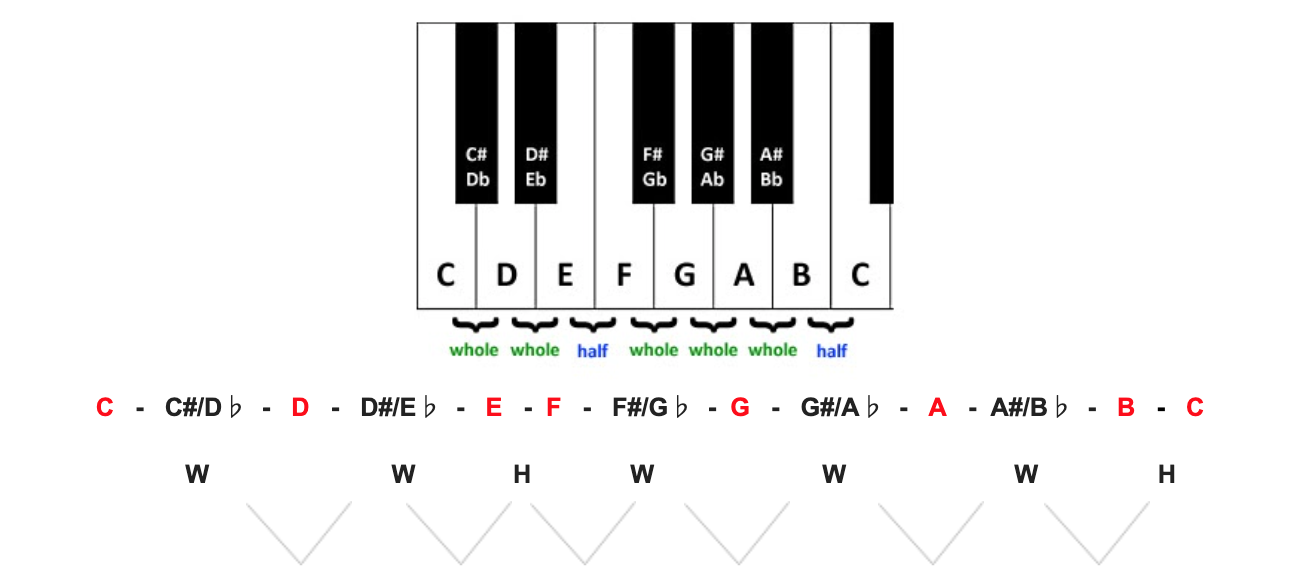
Try playing this scale on your keyboard and then record yourself in the tool above to check your work and share it with friends.
From here, you’ll want to familiarize yourself with other scales like the minor scale, Mixolydian mode, and pentatonic scale. All of these can be learned, visualized and analyzed with the Scale Analyzer. Try learning the minor scale, then head back here to the Piano Recorder to check your work. You'll get an infographic breakdown of how each scale is constructed, and related to other scales. It’s a fun way to spend some of your practice time, and will help you start connecting the dots between keyboarding and music theory/ear training in a flash.
Chords
Early on in your piano playing journey, it’s important to learn songs as a way of improving your technique and learning fundamentals. Nobody wants to learn a bunch of theory mumbo-jumbo and not be able to make music. Chords are the basis for playing songs, so learning some basic chord theory is a great place to start. Make sure you’re playing along on your MIDI keyboard, home piano, or use the online piano keyboard in the tool above to put these examples into practice.
Chords are formed by taking three or more notes and playing them at the same time. These notes can be sounded together, or separately (aka arpeggios).
Chords form the basis of a song's harmony and will be the bulk of early learning when it comes to playing contemporary music on the piano.
There are many types of chords, but you can begin by learning just three. These three chord types are major, minor, and diminished.
First, try playing back these chords here: ToneGym Chord Player.
To understand the formula behind these chords, you’ll need to know three musical intervals: major third, minor third, and perfect fifth. Intervals are the space between musical notes. Each interval has a unique sound based on its distance from the starting note.
A major third is the space between four keys on the piano. If you begin on the note “C” and ascend by four keys (black AND white), you’ll land on the note E.
A minor third is one half-step or piano key lower than a major third. If we begin on “C” and walk up three keys to “Eb”, we’ll hear a minor third.
A perfect fifth is the most stable sounding musical interval other than the perfect octave (same note, played one set of 12 keys apart).
Major chords are formed by placing a major third interval below a minor third interval. The space between the bottom and top notes is a perfect fifth.
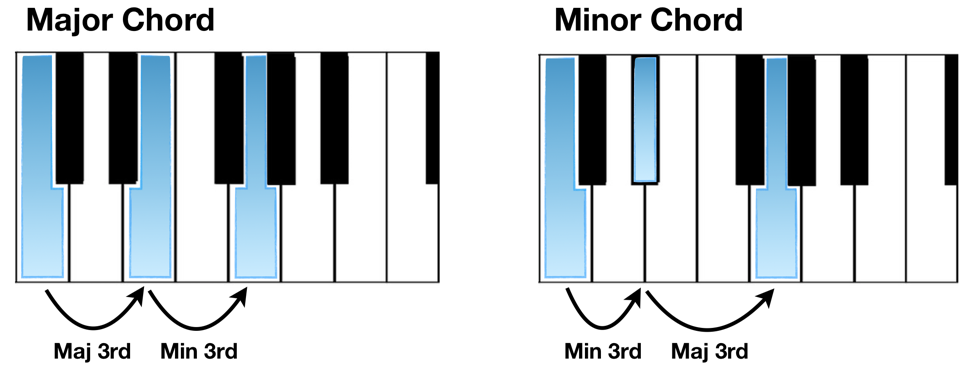
To form a minor chord, we need simply move the middle note “E” down by one half step. This creates a minor third interval on the bottom, and a major third interval on top. The distance between the top and bottom notes is still a perfect fifth.
If we move the top note, the fifth, down by a semitone, the resulting chord is called a diminished chord. This chord is formed from two minor third intervals stacked on top of one another. The chord gets its name from the flat or diminished fifth interval that is now present between the bottom and top notes.
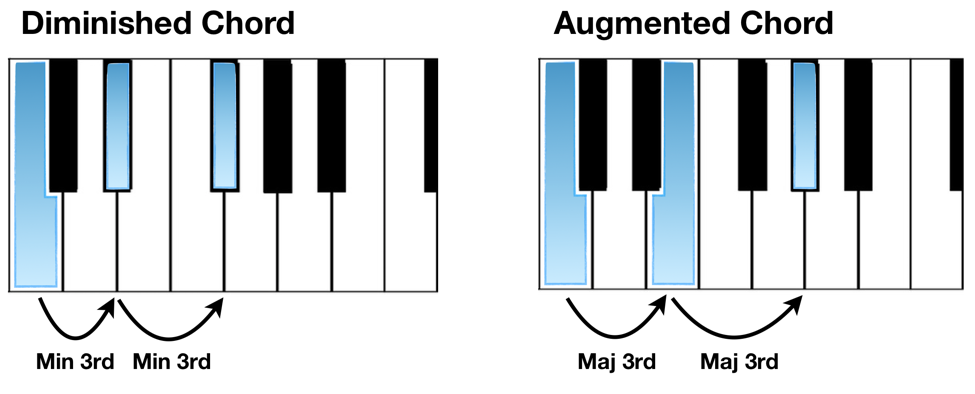
There is one last basic chord type, called augmented, which you can see above. As opposed to a diminished chord, an augmented chord is made of two stacked major third intervals instead of two minor third intervals. The augmented chord does not appear in the chord types built from a standard major scale, so you can worry about this one later.
Chord Progressions
When we arrange two or more chords into a repeating sequence, this is called a chord progression. Chords are how we accompany a band or singer when playing songs. Usually, on the piano chords are played with the left hand (written in the bass clef), while melodies and embellishments are played using the right hand.
The piano is unique because it easily allows us to play both chords and melody at the same time. It’s one of the only instruments that allow us to accompany ourselves.
Chord progressions come from the chords built on each scale degree in the song’s key. These chords are labeled 1 through 7, usually using Roman numerals, like this:

When spelling out a chord progression, we use the numbers assigned to each chord. Uppercase numerals represent chords with a major tonality, while lowercase numerals represent chords with a minor tonality (including diminished chords).
The most basic chord progression in contemporary music is the ubiquitous I - IV - V (called “one, four, five”) progression. This three-chord progression is the foundation for countless pop songs and the entire genre of American Blues music. It comes from taking the first chord in the key, the fourth chord in the key, and the fifth chord in the key, and repeating them in a set pattern.
In the key of C, the chords in this progression are “C”, “F” and “G”. Try programming this progression in the Chord Progression Generator.
Expanding on the I - IV - V progression, we can learn the I - V - vi - IV (one, five, six, four) progression. This common pop progression is famous for being turned into a smart bit of comedy by Aussie band Axis of Awesome. It can be used interchangeably in hundreds if not thousands of hit songs over the last century.
You’ll find this progression labeled, “Pop progression 2” in the Chord Progression Generator.
The most common progression in Jazz music is the ii - V - I progression (also included in the Chord Progression Generator)
There are plenty of progressions to explore, don’t stop here.
Get into the Habit of Practicing
Just like training your ears or learning to draw or paint, improvement only comes from consistent practice. Developing a practice habit of even just 15-20 minutes per day starting out will give you consistently better returns than neglecting your new skill for weeks on end, followed by the odd two-hour training session.
Try to bring variation to your practice regimen. Your brain craves new stimuli, and practicing the same old thing over and over again will make you feel discouraged. Set aside a few minutes to practice playing chords, scales and melodies or reading basic musical notation. Also, take some time for ear training and work on your repertoire of songs.
Whether you’re aspiring to virtuoso status, or simply looking to master the piano as a utility in your music you’ve taken the right first step. Keep practicing and we can’t wait to see (and hear) the results.




